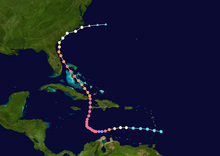 Track of Hurricane Matthew | |
| Meteorological history | |
|---|---|
| Formed | September 28, 2016 |
| Extratropical | October 9, 2016 |
| Dissipated | October 10, 2016 |
| Category 5 major hurricane | |
| 1-minute sustained (SSHWS/NWS) | |
| Highest winds | 165 mph (270 km/h) |
| Lowest pressure | 934 mbar (hPa); 27.58 inHg |
| Overall effects | |
| Areas affected | |
Part of the 2016 Atlantic hurricane season | |
| History
Effects Other wikis | |
Hurricane Matthew was the first Category 5 Atlantic hurricane since Felix in 2007 and the southernmost Category 5 Atlantic hurricane on record. The system originated from a tropical wave that emerged off the west coast of Africa on September 22, and ultimately dissipated as an extratropical cyclone near Atlantic Canada on October 10. Late on September 29, it began a period of explosive intensification that brought it to Category 5 strength early on October 1. It weakened slightly and remained a Category 4 until its landfalls in Haiti and Cuba, afterwards it traversed through the Bahamas and paralleled the coast of Florida until making landfall in South Carolina as a Category 1 hurricane. Matthew later transitioned into a post-tropical cyclone on October 10.
The cyclone was responsible for roughly 600 deaths (with initial reports of up to 1,600), making Matthew the deadliest since Stan in 2005, and caused $15.1 billion (2016 USD) in damages, which made it the costliest since Sandy in 2012. Matthew caused its most destructive entry as it made landfall in Haiti on October 4, causing catastrophic damage and over 500 died as a result. The storm also threatened to be the first major hurricane to strike the United States since Wilma in 2005, however it veered slightly more to the east and remained offshore. The major strike ended up coming a year later. However, torrential rainfall fell in the Carolinas, causing extreme flash flooding. Even as Matthew turned extratropical and moved away from the coast, rivers were still overflowing, and it would take many weeks for the rivers to fall back to average levels. Overall, Matthew caused $10 billion damage in the United States.